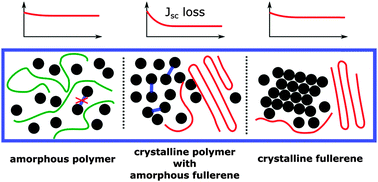Morphological and electrical control of fullerene dimerization determines organic photovoltaic stability†
Abstract
Fullerene dimerization has been linked to short circuit current (Jsc) losses in organic solar cells comprised of certain polymer–fullerene systems. We investigate several polymer–fullerene systems, which present Jsc loss to varying degrees, in order to determine under which conditions dimerization occurs. By reintroducing dimers into fresh devices, we confirm that the photo-induced dimers are indeed the origin of the Jsc loss. We find that both film morphology and electrical bias affect the photodimerization process and thus the associated loss of Jsc. In plain fullerene films, a higher degree of crystallinity can inhibit the dimerization reaction, as observed by high performance liquid chromatography (HPLC) measurements. In blend films, the amount of dimerization depends on the degree of mixing between polymer and fullerene. For highly mixed systems with very amorphous polymers, no dimerization is observed. In solar cells with pure polymer and fullerene domains, we tune the fullerene morphology from amorphous to crystalline by thermal annealing. Similar to neat fullerene films, we observe improved light stability for devices with crystalline fullerene domains. Changing the operating conditions of the investigated solar cells from Voc to Jsc also significantly reduces the amount of dimerization-related Jsc loss; HPLC analysis of the active layer shows that more dimers are formed if the cell is held at Voc instead of Jsc. The effect of bias on dimerization, as well as a clear correlation between PL quenching and reduced dimerization upon addition of small amounts of an amorphous polymer into PC60BM films, suggests a reaction mechanism via excitons.


 Please wait while we load your content...
Please wait while we load your content...